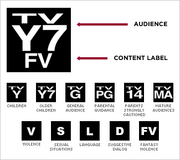What Does Tv Y7 Stand for on Netflix
The TV Parental Guidelines system for the United States is a voluntary-participation system for TV programs, with ratings to be determined by the individual participating broadcast and cable networks. It was first proposed on December 19, 1996 by the United States Congress, the television industry, and the Federal Communications Commission (FCC), and went into effect on January 1, 1997, on most major U.S. broadcast and cable networks in response to public concerns of increasingly explicit sexual content, graphic violence and strong profanity in television programs.

The guidelines are as follows. Often content descriptors will be used to specify the type of content in the program.
Ratings
- TV-Y (All Children) This program is designed to be appropriate for all children. Whether animated or live-action, the themes, and elements in this program are specifically designed for a very young audience, including children from ages 2-6. This program is not expected to frighten younger children. Equivalent to the former EC for video games.
- TV-Y7 (Directed To Older Children) This program is designed for children age 7 and above. It may be more appropriate for children who have acquired the developmental skills needed to distinguish between make-believe and reality. Themes and elements in this program may include fantasy violence or comedic violence or may fear children under the age of 7. Therefore, parents may wish to consider the suitability of this program for their very young children. Equivalent to hard E and soft E10+ for video games.
- TV-G (General Audience) Most parents would find this program suitable for all ages. Although this rating does not signify a program designed specifically for children (because TV-Y uses it), most parents may let younger children watch this program unattended. It contains little or no violence, no strong language, and little or no sexual dialogue or situations. Equivalent to G for movies and E for video games.
- TV-PG (Parental Guidance Suggested) This program contains material that parents may find unsuitable for younger children. Many parents may want to watch it with their younger children. The theme itself may call for parental guidance and/or the program may contain one or more of the following: some suggestive dialogue (D), infrequent coarse language (L), some sexual situations (S), or moderate violence (V). Equivalent to PG for movies and E10+ for video games.
- TV-14 (Parents Strongly Cautioned) This program contains some material that many parents would find unsuitable for children under 14 years of age. Parents are strongly urged to exercise greater care in monitoring this program and are cautioned against letting children under the age of 14 watches unattended. This program may contain one or more of the following: intensely suggestive dialogue (D), strong coarse language (L), intense sexual situations (S), or intense violence (V). Equivalent to PG-13 for movies and T for video games.
- TV-MA (Mature Audiences Only) This program is specifically designed to be viewed by adults and therefore may be unsuitable for children under 17 (or in some cases, under 18). This program may contain one or more of the following: crude indecent language (L), explicit sexual activity (S), or graphic violence (V). Equivalent to R/NC-17 for movies and M/AO for video games. This rating was originally known as TV-M from January until July 1997.
Content descriptors
The content descriptors commonly seen with the main ratings are as follows:
- FV: Fantasy violence (only used with the TV-Y7 rating for action-oriented children's shows).
- D: Used with the TV-PG and TV-14 rating to denote the use of sexually suggestive dialogue (usually sexual references). It is not intended to be used in TV-MA shows (but some networks opt them).
- L: Used with the TV-PG, TV-14, and TV-MA rating to denote instances of crude, offensive language (profanity, vulgar slang, racial and ethnic slurs, etc.).
- S: Used with the TV-PG, TV-14, and TV-MA rating to denote instances of sexual content (including visual innuendo and intercourse).
- V: Used with the TV-PG, TV-14, and TV-MA rating to denote instances of violence.
E/I
E/I which stands for "educational and informational" refers to a type of children's television programming broadcast in the United States that incorporates educational content in some form. It is used for the TV-Y, TV-Y7, and TV-G classifications. This can only be broadcast from 6:00 am to 10:00 pm. Additionally, it can only be aired on free-to-air TV, not paid TV. According to the Children's Television Act of 1990, there are limits in advertising time during children's television programming. It should not exceed 10.5 minutes per hour on weekends and 12 minutes per hour on weekdays.
Notes
Some streaming services, such as Disney+, do not allow TV shows that are rated TV-MA and Movies that are rated R.
Gallery
- For the gallery, see TV Parental Guidelines/Gallery.
| TV Parental Guidelines rating system |
|---|
| |
What Does Tv Y7 Stand for on Netflix
Source: https://rating-system.fandom.com/wiki/TV_Parental_Guidelines